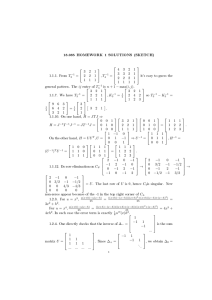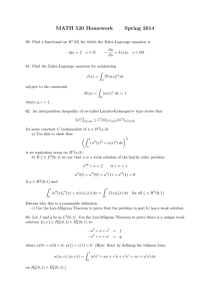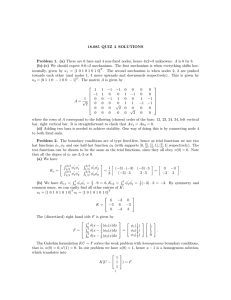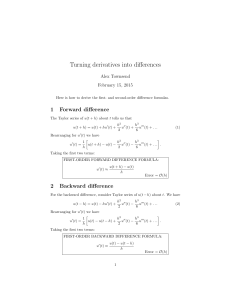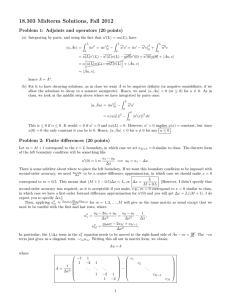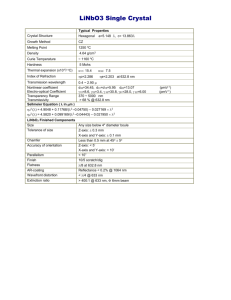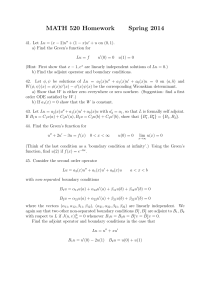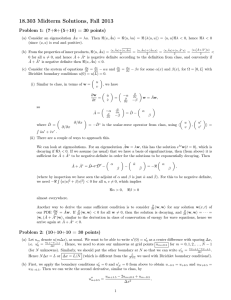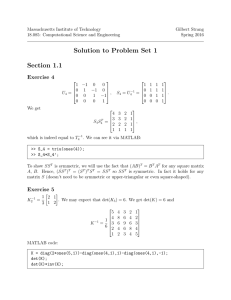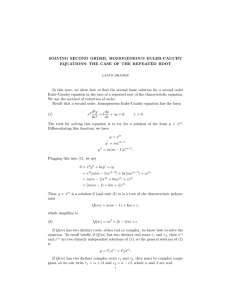Electronic Journal of Differential Equations, Vol. 2007(2007), No. 16, pp.... ISSN: 1072-6691. URL: or
advertisement
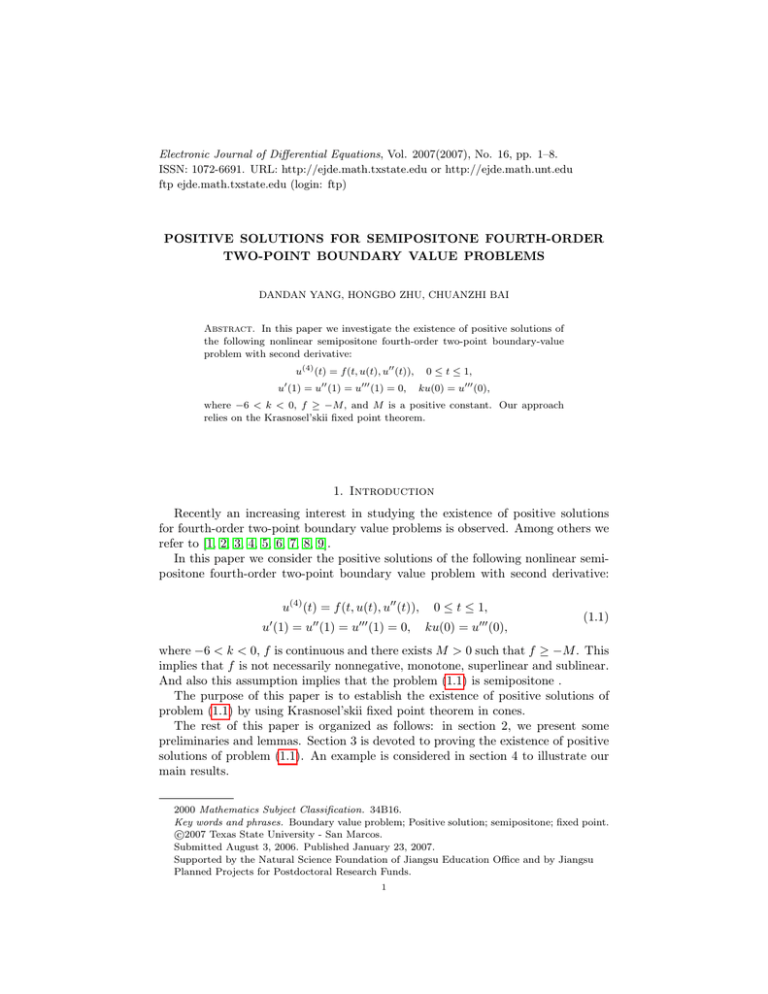
Electronic Journal of Differential Equations, Vol. 2007(2007), No. 16, pp. 1–8.
ISSN: 1072-6691. URL: http://ejde.math.txstate.edu or http://ejde.math.unt.edu
ftp ejde.math.txstate.edu (login: ftp)
POSITIVE SOLUTIONS FOR SEMIPOSITONE FOURTH-ORDER
TWO-POINT BOUNDARY VALUE PROBLEMS
DANDAN YANG, HONGBO ZHU, CHUANZHI BAI
Abstract. In this paper we investigate the existence of positive solutions of
the following nonlinear semipositone fourth-order two-point boundary-value
problem with second derivative:
u(4) (t) = f (t, u(t), u00 (t)),
0
00
000
u (1) = u (1) = u (1) = 0,
0 ≤ t ≤ 1,
ku(0) = u000 (0),
where −6 < k < 0, f ≥ −M , and M is a positive constant. Our approach
relies on the Krasnosel’skii fixed point theorem.
1. Introduction
Recently an increasing interest in studying the existence of positive solutions
for fourth-order two-point boundary value problems is observed. Among others we
refer to [1, 2, 3, 4, 5, 6, 7, 8, 9].
In this paper we consider the positive solutions of the following nonlinear semipositone fourth-order two-point boundary value problem with second derivative:
u(4) (t) = f (t, u(t), u00 (t)),
0
00
000
u (1) = u (1) = u (1) = 0,
0 ≤ t ≤ 1,
ku(0) = u000 (0),
(1.1)
where −6 < k < 0, f is continuous and there exists M > 0 such that f ≥ −M . This
implies that f is not necessarily nonnegative, monotone, superlinear and sublinear.
And also this assumption implies that the problem (1.1) is semipositone .
The purpose of this paper is to establish the existence of positive solutions of
problem (1.1) by using Krasnosel’skii fixed point theorem in cones.
The rest of this paper is organized as follows: in section 2, we present some
preliminaries and lemmas. Section 3 is devoted to proving the existence of positive
solutions of problem (1.1). An example is considered in section 4 to illustrate our
main results.
2000 Mathematics Subject Classification. 34B16.
Key words and phrases. Boundary value problem; Positive solution; semipositone; fixed point.
c
2007
Texas State University - San Marcos.
Submitted August 3, 2006. Published January 23, 2007.
Supported by the Natural Science Foundation of Jiangsu Education Office and by Jiangsu
Planned Projects for Postdoctoral Research Funds.
1
2
D. YANG, H. ZHU, C. BAI,
EJDE-2007/16
2. Preliminaries and lemmas
Let C 2 [0, 1] be the Banach space with norm kuk0 = max{kuk, ku00 k}, where
kuk = max |u(t)|,
u ∈ C[0, 1].
0≤t≤1
By routine calculation, we easily obtain the following Lemma.
Lemma 2.1. If k 6= 0, then
u(4) (t) = h(t),
0
00
0 ≤ t ≤ 1,
000
u (1) = u (1) = u (1) = 0,
ku(0) = u000 (0),
has a unique solution
Z
1
G(t, s)h(s)ds,
u(t) =
0
where the Green function is
1
G(t, s) = −
6
(
6
k
6
k
+ s3 ,
− (s − t)3 + s3 ,
0 ≤ s ≤ t ≤ 1,
0 ≤ t ≤ s ≤ 1.
Remark 2.2. If −6 < k < 0, then
0 < (1 +
1
k
)G(0, s) ≤ G(t, s) ≤ G(0, s) = max G(t, s) = −
0≤t≤1
6
k
(2.1)
in closed bounded region D = {(t, s) : 0 ≤ t ≤ 1, 0 ≤ s ≤ 1}.
Let
Z
p(t) :=
1
G(t, s)ds =
0
1
1 4 1 3 1 2 1
t − t + t − t− ,
24
6
4
6
k
0 ≤ t ≤ 1.
Since
1 3 1 2 1
1
t − t + t−
6
2
2
6
1
1
p00 (t) = t2 − t + =
2
2
p0 (t) =
1
= − (1 − t)3 ≤ 0, 0 ≤ t ≤ 1,
6
1
(1 − t)2 ≥ 0, 0 ≤ t ≤ 1,
2
we have
1
kpk = max p(t) = p(0) = − ,
0≤t≤1
k
min p(t) = p(1) = −
0≤t≤1
kp00 k = max |p00 (t)| =
0≤t≤1
1
1
− ,
k 24
1
.
2
(2.2)
(2.3)
Our approach is based on the following Krasnosel’skii fixed point theorem.
Lemma 2.3. Let X be a Banach space, and K ⊂ X be a cone in X. Assume
Ω1 , Ω2 are bounded open subsets of K with 0 ∈ Ω1 ⊂ Ω1 ⊂ Ω2 , and let F : K → K
be a completely continuous operator such that either
(1) kF uk ≤ kuk, u ∈ ∂Ω1 , and kF uk ≥ kuk, u ∈ ∂Ω2 , or
(2) kF uk ≥ kuk, u ∈ ∂Ω1 , and kF uk ≤ kuk, u ∈ ∂Ω2 .
Then F has a fixed point in Ω2 \ Ω1 .
EJDE-2007/16
POSITIVE SOLUTIONS FOR FOURTH-ORDER BVPS
3
To apply the Krasnosel’skii fixed point theorem, we need to construct a suitable
cone. Let
C02 [0, 1] = {u ∈ C 2 [0, 1] : u(t) ≥ 0, u00 (t) ≥ 0, 0 ≤ t ≤ 1,
u0 (1) = u00 (1) = u000 (1) = 0, ku(0) = u000 (0)}.
It is easy to check that the following set P is a cone in C 2 [0, 1]:
k
P = u ∈ C02 [0, 1] : min u(t) ≥ (1 + )kuk ,
0≤t≤1
6
where −6 < k < 0. For convenience, let
α(r) = max{f (t, u, v) : (t, u, v) ∈ D1 (r)},
(2.4)
β(r) = min{f (t, u, v) : (t, u, v) ∈ D2 (r)},
(2.5)
where
1
1
M
M
≤ u ≤ r + ( + )M, −
≤v≤r ,
D1 (r) = (t, u, v) : 0 ≤ t ≤ 1,
k
k 24
2
1
3 1
175
1
85
D2 (r) = (t, u, v) : ≤ t ≤ , ( +
)M ≤ u ≤ r + ( +
)M,
4
4 k 6144
k 2048
9
1 − M ≤v≤r− M .
32
32
Z 1
Z 1
i−1 o
nh
i−1 h
, max
|G00 (t, s)|ds
= min{−k, 2},
C1 = min
max
G(t, s)ds
0≤t≤1
C2 = max
0≤t≤1
0
nh
3
4
Z
max
0≤t≤1
0
3
4
Z
i−1 h
G(t, s)ds
, max
0≤t≤1
1
4
i−1 o
|G00 (t, s)|ds
1
4
1
1 −1 32 −
= max
+
.
,
2k 6144
9
Obviously, 0 < C1 < C2 .
n
3. Main results
Theorem 3.1. Let −6 < k < 0. Assume that
M
M
f : [0, 1] × [ , +∞) × [− , +∞) → [−M, +∞)
(3.1)
k
2
is continuous, where M > 0 is a constant. Suppose there exist two positive numbers
−6
r1 and r2 with min{r1 , r2 } > 6k+k
2 M such that
α(r1 ) ≤ r1 C1 − M,
β(r2 ) ≥ r2 C2 − M,
(3.2)
where α, β are as in (2.4) and (2.5), respectively. Then problem (1.1) has at least
one positive solution.
Proof. Let u0 (t) = M p(t), 0 ≤ t ≤ 1. Then by (2.1) and (2.3) we have
1
1
M
1
(− − )M ≤ u0 (t) ≤ − , 0 ≤ u000 (t) ≤ M, 0 ≤ t ≤ 1.
k 24
k
2
Consider the fourth-order two-point boundary-value problem
u(4) (t) = f (t, u(t) − u0 (t), u00 (t) − u000 (t)) + M,
0
00
000
u (1) = u (1) = u (1) = 0,
000
ku(0) = u (0),
(3.3)
0 ≤ t ≤ 1,
(3.4)
4
D. YANG, H. ZHU, C. BAI,
EJDE-2007/16
This problem is equivalent to the integral equation
Z 1
u(t) =
G(t, s)[f (s, u(s) − u0 (s), u00 (s) − u000 (s)) + M ]ds.
0
For u ∈ C02 [0, 1], we define the operator A as follows
Z 1
G(t, s)[f (s, u(s) − u0 (s), u00 (s) − u000 (s)) + M ]ds,
(Au)(t) =
0 ≤ t ≤ 1.
0
Computing the second derivative of (Au)(t), we obtain
Z 1
00
(Au) (t) =
(s − t)[f (s, u(s) − u0 (s), u00 (s) − u000 (s)) + M ]ds,
0 ≤ t ≤ 1.
t
Noticing (3.3) and that u ∈ C02 [0, 1], we have
M
≤ u(t) − u0 (t) < +∞,
k
1
− M ≤ u00 (t) − u000 (t) < +∞, 0 ≤ t ≤ 1.
2
Thus, from (3.1) we get
(Au)(t) ≥ 0,
(Au)00 (t) ≥ 0,
t ∈ [0, 1].
By the definition of G(t, s),
G0 (1, s) = G00 (1, s) = G000 (1, s) = 0,
and G000 (0, s) = kG(0, s) = −1,
which implies that
(Au)0 (1) = (Au)00 (1) = (Au)000 (1) = 0,
and k(Au)(0) = (Au)000 (0).
Hence, A : C02 [0, 1] → C02 [0, 1]. Moreover, for each t ∈ [0, 1], (By (2.1) we have
Z 1
(Au)(t) =
G(t, s)[f (s, u(s) − u0 (s), u00 (s) − u000 (s)) + M ]ds
0
k
≥ (1 + )
6
Z
1
G(0, s)[f (s, u(s) − u0 (s), u00 (s) − u000 (s)) + M ]ds
0
Z 1
k
) max
G(t, s)[f (s, u(s) − u0 (s), u00 (s) − u000 (s)) + M ]ds
6 0≤t≤1 0
k
= (1 + )kAuk.
6
Thus, A : P → P .
We can check that A is completely continuous by routine method. Since C1 < C2 ,
it is easy to check that r1 6= r2 . Without loss of generality, we assume r1 < r2 . Let
≥ (1 +
Ω1 = {u ∈ P : kuk0 < r1 },
Ω2 = {u ∈ P : kuk0 < r2 }.
If u ∈ ∂Ω1 , then kuk0 = r1 . So, kuk ≤ r1 and ku00 k ≤ r1 . This implies
0 ≤ u(t) ≤ r1
0 ≤ u00 (t) ≤ r1 ,
By (2.2), for 0 ≤ t ≤ 1, we have
1
1
1
M ≤ u(t) − u0 (t) ≤ r1 +
+
M,
k
k 24
By (3.2),
0 ≤ t ≤ 1.
1
− M ≤ u00 (t) − u000 (t) ≤ r1 .
2
f (t, u(t) − u0 (t), u00 (t) − u000 (t)) ≤ α(r1 ) ≤ r1 C1 − M,
0 ≤ t ≤ 1.
EJDE-2007/16
POSITIVE SOLUTIONS FOR FOURTH-ORDER BVPS
5
It follows that
1
Z
G(t, s)[f (s, u(s) − u0 (s), u00 (s) − u000 (s)) + M ]ds
kAuk = max
0≤t≤1
0
1
Z
≤ r1 C1 max
G(t, s)ds ≤ r1 ,
0≤t≤1
1
Z
00
|G00 (t, s)|[f (s, u(s) − u0 (s), u00 (s) − u000 (s)) + M ]ds
k(Au) k = max
0≤t≤1
0
0
1
Z
|G00 (t, s)|ds ≤ r1 .
≤ r1 C1 max
0≤t≤1
0
Therefore, kAuk0 ≤ r1 = kuk0 .
If u ∈ ∂Ω2 , then kuk0 = r2 . So, kuk ≤ r2 and ku00 k ≤ r2 . This implies that
0 ≤ u(t) ≤ r2 ,
0 ≤ u00 (t) ≤ r2 ,
0 ≤ t ≤ 1.
Since
−
85
1
3
1
175
1
1
3
− = p( ) ≤ p(t) ≤ p( ) = −
− ,
≤t≤ ,
2048 k
4
4
6144 k
4
4
1
1
9
1
3
00
2
≤ p (t) = (1 − t) ≤
,
≤t≤ ,
32
2
32
4
4
we have
(
1
175
1
85
+
)M ≤ u(t) − u0 (t) ≤ r2 + ( +
)M,
k 6144
k 2048
1
3
≤t≤ ,
4
4
and
9
M
M ≤ u00 (t) − u000 (t) ≤ r2 −
,
32
32
Thus, by (3.2) we obtain
−
1
3
≤t≤ .
4
4
f (t, u(t) − u0 (t), u00 (t) − u000 (t)) ≥ β(r2 ) ≥ r2 C2 − M,
1
3
≤t≤ .
4
4
From this,
3
4
Z
kAuk ≥ max
0≤t≤1
1
4
G(t, s)[f (s, u(s) − u0 (s), u00 (s) − u000 (s)) + M ]ds
3
4
Z
≥ r2 C2 max
G(t, s)ds ≥ r2 ,
0≤t≤1
1
4
and
k(Au)00 k ≥ max
3
4
Z
0≤t≤1
1
4
G00 (t, s)[f (s, u(s) − u0 (s), u00 (s) − u000 (s)) + M ]ds
3
4
Z
≥ r2 C2 max
0≤t≤1
G00 (t, s)ds ≥ r2 .
1
4
It follows that kAuk0 ≥ r2 = kuk0 . By Lemma 2.3, we assert that the operator A
has at least one fixed point u ∈ P with r1 ≤ kuk0 ≤ r2 . This implies that (3.4) has
at least one solution u ∈ P with r1 ≤ kuk0 ≤ r2 .
6
D. YANG, H. ZHU, C. BAI,
EJDE-2007/16
Let u∗ (t) = u(t) − u0 (t), 0 ≤ t ≤ 1. We will check that u∗ is a solution of the
problem (1.1). In fact, since Au = u, we have
u∗ (t) + u0 (t) = u(t) = (Au)(t)
Z 1
=
G(t, s)[f (s, u(s) − u0 (s), u00 (s) − u000 (s)) + M ]ds
0
1
Z
G(t, s)f (s, u∗ (s), u00∗ (s))ds + u0 (t).
=
0
It follows that
Z
u∗ (t) =
1
G(t, s)f (s, u∗ (s), u00∗ (s))ds,
0 ≤ t ≤ 1.
0
In other words, u∗ is a solution of (1.1). Therefore, the problem (1.1) has at least
one solution u∗ satisfying u∗ + u0 ∈ P and r1 ≤ ku∗ + u0 k0 ≤ r2 .
6
Since r1 = min{r1 , r2 } > − 6k+k
2 M , we have
u∗ (t) = [u∗ (t) + u0 (t)] − u0 (t) = [u∗ (t) + u0 (t)] − M p(t)
M
k
)ku∗ (t) + u0 (t)k +
6
k
6
k
M ] > 0,
≥ (1 + )[r1 +
6
6k + k 2
≥ (1 +
0 ≤ t ≤ 1,
which implies that u∗ is a positive solution of (1.1).
Using Theorem 3.1, we can prove following result.
Theorem 3.2. Let −6 < k < 0. Assume that
M
M
f : [0, 1] × [ , +∞) × [− , +∞) → [−M, +∞)
(3.5)
k
2
is continuous, where M ≥ 0 is a constant. Suppose that there exist three positive
6
numbers r1 < r2 < r3 with r1 > − 6k+k
2 M such that one of the following conditions
is satisfied:
(1) α(r1 ) ≤ r1 C1 − M , β(r2 ) > r2 C2 − M , α(r3 ) ≤ r3 C1 − M ;
(2) β(r1 ) ≥ r1 C2 − M , α(r2 ) < r2 C1 − M , β(r3 ) ≥ r3 C2 − M .
Then problem (1.1) has at least two positive solutions.
4. Examples
Example 4.1. Consider the boundary-value problem
u(4) (t) = f (t, u(t), u00 (t)),
0
00
000
u (1) = u (1) = u (1) = 0,
0 ≤ t ≤ 1,
−2u(0) = u000 (0),
(4.1)
where f : [0, 1] × [−1, +∞) × [−1, +∞) → [−2, +∞) is defined by
2 √
√
t + u + 1 + 9 v +√1 − 2,
(t, u, v) ∈ [0, 1] × [−1, − 21 ] × [−1, − 21 ],
√
t2 + u + 9 v + 1 + 2 − 15 , (t, u, v) ∈ [0, 1] × [− 1 , ∞) × [−1, − 1 ],
4
2
8
2
2
√
f (t, u, v) = 2 √
t + u + 1 + v5 + 92 2 − 19
, (t, u, v) ∈ [0, 1] × [−1, − 12 ] × [− 12 , ∞),
10
√
2 u v
t + 4 + 5 + 5 2 − 71
(t, u, v) ∈ [0, 1] × [− 21 , ∞) × [− 12 , ∞).
40 ,
EJDE-2007/16
POSITIVE SOLUTIONS FOR FOURTH-ORDER BVPS
7
Thus, k = −2, M = 2, C1 = 2 and C2 = 6144
1537 . For
11
D1 (r) = (t, u, v) : 0 ≤ t ≤ 1, −1 ≤ u ≤ r − , −1 ≤ v ≤ r ,
12
1
3
2897
939
9
1
D2 (r) = (t, u, v) : ≤ t ≤ , −
≤u≤r−
, −
≤v≤r−
.
4
4
3072
1024
16
16
By simple computations, we obtain
α(6) = max{f (t, u, v) : (t, u, v) ∈ D1 (6)}
61 1
1
1 1 61
= max f (1, , 6), f (1, , − ), f (1, − , 6), f (1, − , − )
12
12 2
2
2 2
61
= f (1, , 6) = 8.76 < 10 = 6C1 − M,
12
and
β(
13
)
8
13 = min f (t, u, v) : (t, u, v) ∈ D2 ( )
8
1 2897
9
1 2897 1
1 1
9
1 1 1 = min f ( , −
, − ), f ( , −
, − ), f ( , − , − ), f ( , − , − )
4 3072 16
4 3072 2
4 2 16
4 2 2
1 2897
9
13
= f( , −
, − ) = 4.76 > 4.49 =
C2 − M.
4 3072 16
8
Take r1 = 6 and r2 = 13
8 . Then (3.2) holds. Moreover, we have
13
3
6
> =−
M.
8
2
6k + k 2
So, by Theorem 3.1, problem (4.1) has at least one positive solution.
min{r1 , r2 } =
References
[1] A. R. Aftabizadeh; Existence and uniqueness theorems for fourth-order boundary problems,
J. Math. Anal. Appl. 116 (1986) 415-426.
[2] R. P. Agarwal; Focal Boundary Value Problems for Differential and Difference Equations,
Kluwer Academic, Dordrecht, 1998.
[3] Z. Bai, H. Wang; On positive solutions of some nonlinear fourth-ordr beam equations, J.
Math. Anal. Appl. 270 (2002) 357-368.
[4] J. R. Graef, B. Yang; On a nonlinear boundary value problem for fourth order equations,
Appl. Anal. 72 (1999) 439-448.
[5] Yanping Guo, Weigao Ge, Ying Gao; Twin positive solutions for higher order m-point boundary value problems with sign changing nonlinearities, Appl. Anal. Comput. 146 (2003) 299311.
[6] Z. Hao, L. Liu; A necessary and sufficiently condition for the existence of positive solution
of fourth-order singular boundary value problems, Appl. Math. Lett. 16 (2003) 279-285.
[7] B. Liu; Positive solutions of fourth-order two-point boundary value problems, Appl. Math.
Comput. 148 (2004) 407-420.
[8] M. A. D. Peno, R. F. Manasevich; Existence for a fourth-order boundary value problem under
a two-parameter nonresonance condition, Proc. Amer. Math. Soc. 112 (1991) 81-86.
[9] Yu Tian, Weigao Ge; Twin positive solutions for fourth-order two-point boundary value problems with sign changing nonlinearities, Electronic Journal of Differential Equations, Vol. 2004
(2004) No. 143, 1-8.
Dandan Yang
Department of Mathematics, Yanbian University, Yanji, Jilin 133000, China.
Department of Mathematics, Huaiyin Teachers College, Huaian, Jiangsu 223001, China
E-mail address: yangdandan2600@sina.com
8
D. YANG, H. ZHU, C. BAI,
EJDE-2007/16
Hongbo Zhu
Department of Mathematics, Yanbian University, Yanji, Jilin 133000, China.
Department of Mathematics, Huaiyin Teachers College, Huaian, Jiangsu 223001, China
E-mail address: zhuhongbo8151@sina.com
Chuanzhi Bai
Department of Mathematics, Huaiyin Teachers College, Huaian, Jiangsu 223001, China
E-mail address: czbai8@sohu.com
